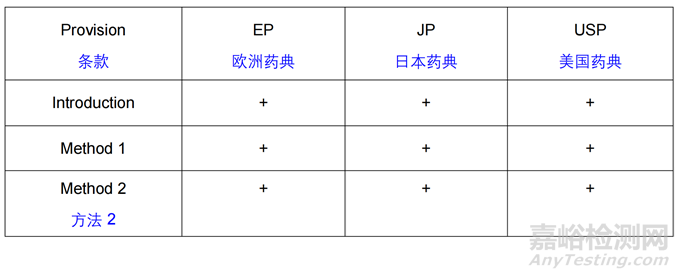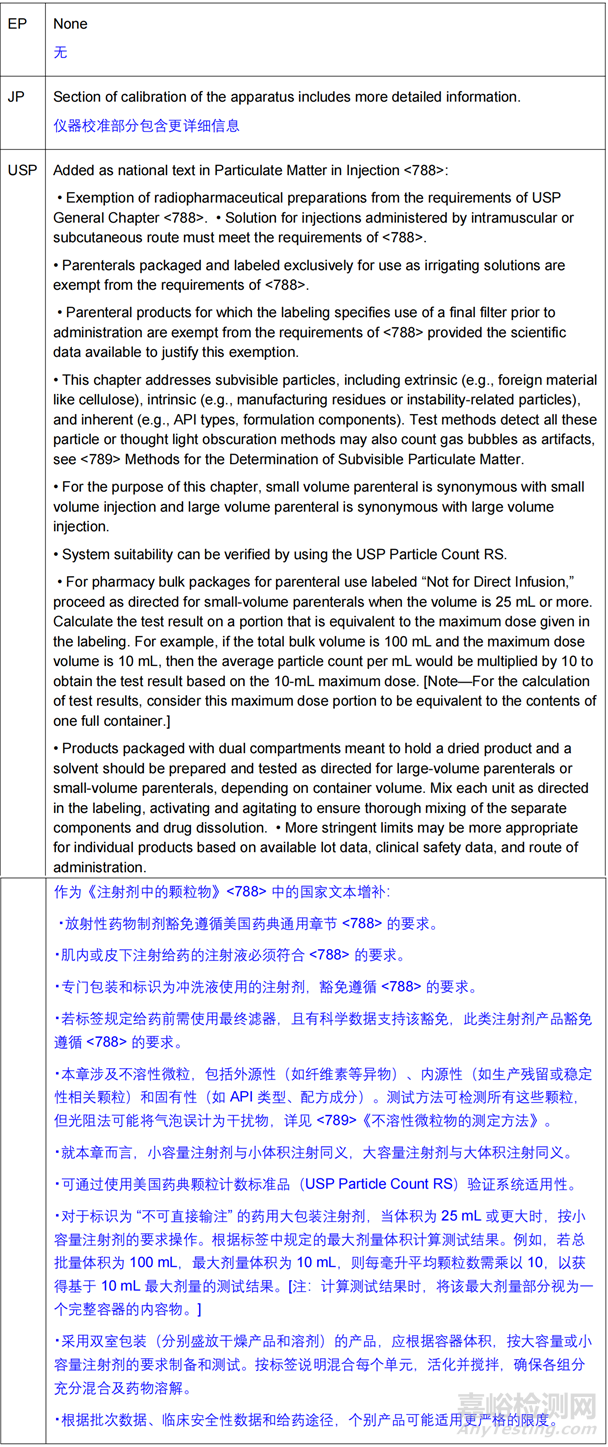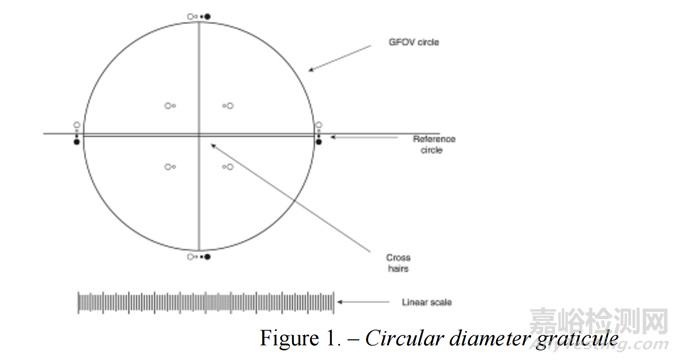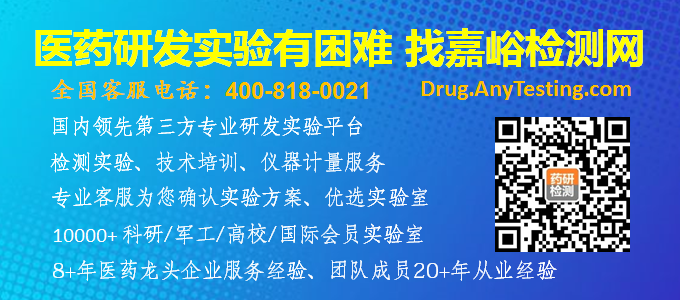近日,EDQM发布对《欧洲药典》总论 不溶性微粒检测 重大修订的公告,如下:
The revised harmonised general chapter "Particulate Contamination (Q-09)" was signed-off by the Pharmacopeial Discussion Group (PDG) on 2 May 2025. The PDG brings together the European Pharmacopoeia (Ph. Eur.), the Indian Pharmacopoeia Commission (IPC), the Japanese Pharmacopoeia (JP) and the United States Pharmacopeia (USP).
经修订的协调总论《颗粒物污染(Q-09)》于 2025 年 5 月 2 日由药典讨论组(PDG)审定通过。PDG 汇聚了欧洲药典(Ph. Eur.)、印度药典委员会(IPC)、日本药典(JP)和美国药典(USP)。
The revision of Q-09 represents a significant step forward in standardised testing procedures for sub-visible particulate matter in all injectable products applied in the PDG regions. This update makes the process more robust and adaptable to different product types, including biologicals. Major changes include:
Q-09 的修订标志着 PDG 区域内所有注射剂产品中不溶性微粒的标准化检测程序向前迈出重要一步。此次更新使流程更稳健,且能适配包括生物制品在内的不同产品类型。主要变化包括:
Definition clarification
定义澄清
Guidance on sample preparation, especially for formulations with a volume of 25 mL or less
样品制备指导(尤其针对体积≤25 mL 的制剂)
Method 1 (light obscuration particle count test) updates
Method 2 (microscopic particle count test) updates
方法 2(显微法颗粒计数测试)更新
These revisions ensure clear, comprehensive standards aligned with current scientific and regulatory expectations, ultimately contributing to improved drug development and public health. The well-established acceptance criteria have been kept from the previous version of the text. The full sign-off text can be found on the website. The corresponding regional texts for the harmonised general chapter on Particulate Contamination are scheduled for publication in April 2026 (JP general test <6.07>), July 2026 (Ph. Eur. general chapter 2.9.19), and July 2025 are scheduled for <788> with <787> to be omitted in the future). The IPC as newest member will sign and implement the text at a later stage according to its implementation plan for all PDG harmonised texts。
这些修订确保了清晰、全面的标准,与当前科学和监管预期一致,最终助力药物研发改进与公共健康提升。先前版本中已确立的接受标准得以保留。完整审定文本可在官网查阅。颗粒物污染协调总论的对应区域文本计划于 2026 年 4 月(日本药典通用测试 <6.07>)、2026 年 7 月(欧洲药典总论 2.9.19)发布,且 2025 年 7 月计划发布 < 788>(未来 < 787 > 将被废止)。作为最新成员的印度药典委员会(IPC)将依据其针对所有 PDG 协调文本的实施计划,在后续阶段签署并执行该文本。
The PDG has successfully harmonised all the general chapters on its work programme (31) in addition to 48 of the 62 excipient monographs listed. The current work programme, including all ongoing items, is available on the website (General chapters, Excipients).
除所列 62 项辅料专论中的 48 项外,PDG 已成功协调其工作方案中的全部总论(共 31 项)。当前工作方案(含所有在研项目)可在官网查阅(总论、辅料板块)。
具体内容如下:
PHARMACOPOEIAL DISCUSSION GROUP
药典讨论小组
SIGN-OFF DOCUMENT
签署文件
CODE: Q-09
代码:Q-09
NAME: PARTICULATE CONTAMINATION
名称:颗粒物污染
REVISION 2
修订版 2
It is understood that sign-off covers the technical content of the draft and each party will adapt it as necessary to conform to the usual presentation of the pharmacopoeia in question; such adaptation includes stipulation of the particular pharmacopoeia’s reference materials and general chapters.
各方理解,签署行为涵盖草案的技术内容,且各方将根据需要对其调整,以符合所涉药典的常规表述形式;此类调整包括规定特定药典的标准物质和总论。
Harmonised provisions:
协调条款:
Legend
图例:
+ will adopt and implement; − will not stipulate
+表示 “将采用并实施”;− 表示 “将不规定”
Non-harmonised provisions:
非协调条款:
The requirements for preparations supplied in containers with a nominal value of 100 mL
对装量 100 mL 容器中的制剂的要求
Local requirements
当地要求
Q-09 PARTICULATE CONTAMINATION: SUB-VISIBLE PARTICLES
Q-09 颗粒物污染:不溶性微粒
Unintended particulate matter in parenteral preparations consists of mobile undissolved substances, other than gas bubbles, that may originate from various sources such as contamination. The level of particulate matter must be minimised and controlled, independent of its type.
注射剂中的非预期颗粒物由可移动的未溶解物质(气泡除外)组成,这些物质可能来自污染等各类来源。无论颗粒物的类型如何,都必须将其含量降至最低并加以控制。
For the determination of sub-visible particulate matter 2 procedures are described hereafter: Method 1 (Light Obscuration Particle Count Test) and Method 2 (Microscopic Particle Count Test). It is preferable to use Method 1 when examining the parenteral preparation for sub-visible particles.
为测定不溶性微粒,以下阐述两种方法:方法 1(光阻法颗粒计数试验)和方法 2(显微法颗粒计数试验)。检查注射剂中的不溶性微粒时,优先采用方法 1。
However, not all parenteral preparations can be examined directly for sub-visible particles by one or both of these methods. When Method 1 is not applicable, e.g. in case of preparations having reduced clarity or increased viscosity (some emulsions, suspensions, colloids, and liposomal preparations are examples), the test is carried out according to Method 2. Similarly, specific precautions may be required for preparations that produce air or gas bubbles when drawn into the sensor. If the viscosity of the preparation to be tested precludes its examination by either procedure, a quantitative dilution with an appropriate particle-free diluent may be made to decrease viscosity to a value that allows the analysis to be performed.
然而,并非所有注射剂都能通过这一种或两种方法直接检测不溶性微粒。当方法 1 不适用时(例如,制剂澄清度低或粘度大的情况,如某些乳剂、混悬液、胶体和脂质体制剂),则按方法 2 进行试验。同样,对于吸入传感器时会产生气泡的制剂,可能需要采取特定的预防措施。若待测试制剂的粘度导致无法通过任一方法检测,可用适当的无颗粒稀释剂进行定量稀释,将粘度降低至允许分析的数值。
Obscuration methods measure different characteristics, the results of the Light Obscuration Particle Count Test are not equivalent to those of the Microscopic Particle Count Test and the two methods cannot be considered interchangeable.
光阻法测量的是不同特性,光阻法颗粒计数试验的结果与显微法颗粒计数试验的结果并不等效,且这两种方法不可视为可互换。
The results obtained when examining a discrete unit or group of units cannot be extrapolated with certainty to other units that remain untested. Thus, statistically sound sampling plans based on product and process characteristics must be developed if valid inferences are to be drawn from observed data to characterise the level of particulate matter in a large group of units.
检测单个单元或一组单元所得的结果,无法确定地外推至未检测的其他单元。因此,若要从观测数据合理推断大量单元中颗粒物的含量水平,必须制定基于产品和工艺特性、统计学的抽样计划。
METHOD 1. LIGHT OBSCURATION PARTICLE COUNT TEST
方法 1:光阻法颗粒计数试验
Use a suitable apparatus based on the principle of light blockage that allows an automatic determination of the size of particles and the number of particles according to size.
使用基于光阻原理的合适仪器,该仪器可自动测定颗粒大小及不同粒径的颗粒数量。
The apparatus is calibrated using suitable certified reference materials consisting of dispersions of spherical particles of known sizes at about 10 µm and 25 µm. These standard particles are dispersed in particle-free water R. Care must be taken to avoid agglomeration of particles during dispersion.
仪器需用合适的认证标准物质校准,该标准物质由已知粒径(约 10 µm 和 25 µm)的球形颗粒分散液组成。这些标准颗粒分散在无颗粒水 R 中,分散过程中必须注意避免颗粒团聚。
General precautions
一般注意事项
Carry out the test under conditions limiting further contamination with particles, preferably in a laminar-flow cabinet.
试验应在防止进一步颗粒污染的条件下进行,优先选择在层流操作柜中操作。
Very carefully wash glassware and the equipment used in the test procedure by cleaning with a warm detergent solution and rinsing with abundant amounts of water to remove all traces of detergent. Immediately before use, rinse the fluid path with particle-free water R.
需非常仔细地清洗试验所用的玻璃器皿和设备:先用温热的洗涤剂溶液清洗,再用大量水冲洗以除去所有洗涤剂残留。使用前立即用无颗粒水 R 冲洗流体通路。
Take care not to introduce air bubbles into the preparation to be examined, especially when fractions of the preparation are being transferred to the container in which the determination is to be carried out.
注意不要将气泡引入待检测的制剂中,尤其在将制剂分取转移至测定用容器时。
In order to check that the environment is suitable for the test, that the glassware is properly cleaned and that the water to be used is particle-free, carry out the following test: determine the particle count in 5 aliquots of 5 mL of particle-free water R or an alternative particle-free diluent if justified, each of degassed according to the method described below. If the number of particles of 10 µm or greater size exceeds 25 for the combined 25 mL, the precautions taken for the test are not sufficient. The preparatory steps must be repeated until the environment, glassware and water are suitable for the test.
为检查环境是否适合试验、玻璃器皿是否清洗干净以及所用的水是否无颗粒,需进行以下试验:取 5 份 5 mL 的无颗粒水 R(如有正当理由,可使用其他无颗粒稀释剂),每份按以下方法脱气,测定其中的颗粒数。若合并 25 mL 中粒径≥10 µm 的颗粒数超过 25,则试验采取的预防措施不足,必须重复准备步骤,直至环境、玻璃器皿和水都适合试验。
Method
方法
Clean the outer surfaces of the container(s) using a jet of particle-free water R and avoid contamination of the contents. Samples are tested in a manner that most closely represents the product use. For parenteral preparations that have a sufficient volume for a single test, test individual units to estimate the level and variation of particulate matter in an entire group of units.
用无颗粒水 R 清洗容器外表面,避免污染内容物。样品的测试方式应尽可能接近产品的使用方式。对于单份试验体积足够的注射剂,测试单个单元以估计整组单元中颗粒物的含量水平和变异性。
For parenteral preparations that do not have a sufficient volume for a single test, carefully and thoroughly mix each unit. Then combine the contents of a suitable number of units in a separate container, to obtain the volume required for a single test, based on instrument capability and properties of the sample.
对于单份试验体积不足的注射剂,需仔细并充分混合每个单元,然后将适量数量单元的内容物合并到单独的容器中,根据仪器性能和样品特性,获得单份试验所需的体积。
Powers for injections and infusions are reconstituted with particle-free water R or an alternative particle-free diluent when particle-free water R is not suitable.
注射用粉末和输液剂如需复溶,若无颗粒水 R 不适用,则用无颗粒水 R 或其他合适的无颗粒稀释剂复溶。
Eliminate gas bubbles by appropriate measures such as allowing to stand, applying a gentle vacuum, or sonicating. Preparations containing proteins should not be sonicated. After sample treatment, the sample should be remixed gently but thoroughly to suspend the particles, taking care to minimize the generation of bubbles.
通过静置、施加轻微真空或超声等适当措施除去气泡,含蛋白质的制剂不得超声。样品处理后,应轻轻但充分地重新混合样品以悬浮颗粒,注意尽量减少气泡产生。
The number of test samples must be adequate to provide a statistically sound assessment. For large and small volume parenterals, an adequate volume of test sample must be provided for analysis; however, single units may be tested in a statistically sound sampling plan.
测试样品的数量必须足够,以提供统计学上可靠的评估。对于大容量和小容量注射剂,必须提供足够体积的测试样品用于分析;不过,单个单元可在统计学合理的抽样计划中进行测试。
Remove 4 portions, each of approximately 5 mL, and count the number of particles equal to or larger than 10 µm and 25 µm. Disregard the result obtained from the first portion and calculate the average number of particles from the remaining portions of the preparation to be examined. The number of particles per unit is calculated from the number of particles per volume. Volumes smaller than 5 mL can also be tested provided that this amount is appropriately justified. In general, for parenteral products that do not have a sufficient volume (e.g. less than 25 mL), it may be acceptable to carry out the test with a volume of 1 to 5 mL.
移取 4 份,每份约 5 mL,计数粒径≥10 µm 和≥25 µm 的颗粒数。舍去第一份的结果,从待检测制剂的剩余份中计算颗粒数的平均值。每单位的颗粒数由单位体积的颗粒数计算得出。如经论证,也可测试小于 5 mL 的体积。一般而言,对于体积不足的注射剂(如小于 25 mL),使用 1 至 5 mL 的体积进行试验可能是可接受的。
Evaluation
评估
For preparations supplied in units that contain a nominal volume of more than 100 mL, apply the criteria of test 1.A.
对于以单位包装供应、标称体积大于 100 mL 的制剂,采用试验 1.A 的判定标准。
For preparations supplied in units that contain a nominal volume of less than 100 mL, apply the criteria of test 1.B.
对于以单位包装供应、标称体积小于 100 mL 的制剂,采用试验 1.B 的判定标准。
For preparations supplied in units that contain a nominal volume of 100 mL, apply the criteria of test 1.A (JP requirements) or those of test 1.B (Ph. Eur. and USP requirements).
对于以单位包装供应、标称体积为 100 mL 的制剂,采用试验 1.A 的标准(日本药典要求)或试验 1.B 的标准(欧洲药典和美国药典要求)。
If the number of particles in a tested unit exceeds the limits, test the preparation by the microscopic particle count test.
若被测单元中的颗粒数超过限值,则采用显微颗粒计数试验检测该制剂。
Test 1.A – Preparations for infusion or injection supplied in units that contain a nominal content of more than 100 mL
试验 1.A—— 单位包装标称体积超过 100 mL 的输液或注射剂
The preparation complies with the test if, in each unit tested, the number of particles present per unit that are 10 µm or larger in size does not exceed 25 per millilitre and the number of particles that are 25 µm or larger in size does not exceed 3 per millilitre.
若每个被测单元中,粒径≥10 µm 的颗粒数每毫升不超过 25 个,且粒径≥25 µm 的颗粒数每毫升不超过 3 个,则该制剂符合试验要求。
Test 1.B – Preparations for infusion or injection supplied in units that contain a nominal content of less than 100 mL
试验 1.B—— 单位包装标称体积小于 100 mL 的输液或注射剂
The preparation complies with the test if, in each unit tested, the number of particles present per unit that are 10 µm or larger in size does not exceed 6000 per container and the number of particles that are 25 µm or larger in size does not exceed 600 per container. Where combining units is required, the average number of particles present in the combined sample is used to calculate the number of particles in one container.
若每个被测单元中,粒径≥10 µm 的颗粒数每容器不超过 6000 个,且粒径≥25 µm 的颗粒数每容器不超过 600 个,则该制剂符合试验要求。若需合并单元,以合并样品中的平均颗粒数计算单个容器中的颗粒数。
When justified and authorized for example in cases of highly viscous preparations, dilution of samples may be required to obtain reliable results. Dilution is allowed provided that the diluent and methods are demonstrated to be appropriate and the smallest level of dilution that allows for reproducible testing is used.
当经论证并经批准时,可能需稀释样品(如针对高粘度制剂)以获得可靠结果。在证明稀释剂和方法适用,且采用能实现可重复测试的最小稀释度的情况下,则允许稀释。
METHOD 2. MICROSCOPIC PARTICLE COUNT TEST
方法 2. 显微颗粒计数试验
Use a suitable binocular microscope and a filter assembly to retain particulate matter on a membrane filter.
使用合适的双目显微镜和滤器组件,将颗粒物截留到膜滤器上。
The microscope is equipped with an ocular micrometer calibrated with an objective micrometer, a mechanical stage capable of holding and traversing the entire filtration area of the membrane filter, a suitable illuminator to provide episcopic illumination in addition to oblique illumination, and its diameter grade to 100 (see Figure 1).
显微镜配备经物镜测微尺校准的目镜测微尺、可固定并遍历膜滤器整个过滤区域的机械载物台、除斜射照明外还能提供落射照明的合适照明装置,且其直径规格为 100(见图 1)。
The ocular micrometer is a circular diameter graticule (100 magnifications) and consists of a large circle divided by crosshairs into quadrants, transparent scale graduated circles 10 µm and 25 µm in diameter at 100 magnifications, and a linear black reference in 10 µm increments. It is calibrated using a stage micrometer that is certified by either a domestic or international standard institution. A relative error of its linear scale of the graticule within 2 per cent is acceptable. The large circle is designated the graticule field of view (FOV).
目镜测微尺为圆形直径分划板(100 倍放大),由十字线划分为象限的大圆圈、100 倍放大下直径为 10 µm 和 25 µm 的透明刻度圆圈,以及 10 µm 增量的黑色线性参考线组成。它需用经国内或国际标准机构认证的载物台测微尺校准,分划板线性刻度相对误差在 2% 以内可接受。大圆圈指定为分划板视野(FOV)。
2 illuminators are required. One is an episcopic brightfield illuminator internal to the microscope, the other is an external, focusable auxiliary illuminator adjustable to give reflected oblique illumination at an angle of 10 - 20°.
需配备两种照明装置:一种是显微镜内置的落射明场照明器,另一种是外置、可聚焦的辅助照明器,可调节至 10 - 20° 角提供反射斜射照明。
The filter assembly consists of a filter holder made of glass or other suitable material,
滤器组件包括由玻璃或其他合适材料制成的滤器支架,
and is equipped with a vacuum source and a suitable membrane filter.
并配备真空源和合适的膜滤器。
The membrane filter is of suitable size, black or dark grey in colour, non - gridded or gridded, and 1.0 µm or finer in nominal pore size.
膜滤器尺寸合适,颜色为黑色或深灰色,可为无网格或有网格,标称孔径为 1.0 µm 或更细。
General precautions
一般注意事项
Carry out the test under conditions limiting further contamination with particles, preferably in a laminar-flow cabinet.
在防止进一步颗粒污染的条件下进行试验,优先选择在层流操作柜中进行。
Very carefully wash the glassware and filtration assembly used, except for the membrane filter, with a warm detergent solution and rinse with abundant amounts of water to remove all traces of detergent. Immediately before use, rinse both sides of the membrane filter and the equipment from top to bottom, outside and then inside, with particle-free water R.
除膜滤器外,需非常仔细地用温热洗涤剂溶液清洗所用玻璃器皿和过滤组件,再用大量水冲洗以除去所有洗涤剂残留。使用前立即用无颗粒水 R 冲洗膜滤器两面及设备(先外后内、从上到下)。
In order to check that the environment is suitable for the test, that the glassware and the membrane filter are properly cleaned and that the water to be used is particle-free, carry out the following test: determine the level of particulate matter of a 50-mL volume of particle-free water R following the procedure described below. If more than 20 particles 10 µm or larger in size or, if more than 3 particles 25 µm or larger in size are present within the filtration area, the precautions taken for the test are not sufficient. The preparatory steps must be repeated until the environment, glassware, membrane filter and water are suitable for the test.
为核查环境是否适用于试验、玻璃器皿和膜滤器是否清洗合格,以及所用的水是否无颗粒,需进行以下试验:按下述步骤测定 50 mL 无颗粒水 R 中的颗粒物水平。若过滤区域内粒径≥10 µm 的颗粒数超过 20 个,或粒径≥25 µm 的颗粒数超过 3 个,则试验采取的防护措施不足。必须重复准备步骤,直至环境、玻璃器皿、膜滤器和水均满足试验要求。
Method
方法
Clean the outer surfaces of the container(s) using a jet of particle-free water R and avoid contamination of the contents. Samples are tested in a manner that most closely represents the product use. For parenteral preparations that have a sufficient volume for a single test, testing of individual units is often preferred to estimate the level and variation of particulate matter in an entire group of units.
用无颗粒水 R 喷射清洗容器外表面,避免污染内容物。样品测试方式应尽可能贴近产品实际使用情况。对于单份试验体积足够的注射剂,通常优先测试单个单元,以估算整组单元中颗粒物的含量水平及变异情况。
For parenteral preparations that do not have a sufficient volume for a single test, carefully and thoroughly mix each unit. Then combine the contents of a suitable number of units in a separate container to obtain the volume required for a single test based on instrument capability and properties of the sample.
对于单份试验体积不足的注射剂,需仔细充分混合每个单元,再将适量单元的内容物合并到单独容器中,根据仪器性能和样品特性,获取单份试验所需体积。
Lyophilized solids or powders for injections and infusions are reconstituted with particle-free water R or an alternative particle-free diluent when particle-free water R is not suitable.
注射用冻干固体、粉末及输液剂如需复溶,若无颗粒水 R 不适用,可用无颗粒水 R 或其他合适的无颗粒稀释剂复溶。
The number of test samples must be adequate to provide a statistically sound assessment. For large and small volume parenterals, an adequate volume of sample must be provided for analysis; however, single units may be tested in a statistically sound sampling plan.
测试样品数量需足够,以提供统计学上可靠的评估。对于大、小体积注射剂,均需提供足够体积的样品用于分析;不过,单个单元可在统计学合理的抽样计划中测试。
Wet the inside of the filter holder fitted with the membrane filter with several millilitres of particle-free water R. Transfer to the filtration funnel the total volume of a sample pool or a single unit and apply vacuum. If needed, add last portion, rinse the inner unit or the entire volume is filtered. After adding the sample a portion of the inner walls of the filter holder by using a jet of particle-free water R. Maintain the vacuum until the surface of the membrane filter is free from liquid. Place the filter in a Petri dish and allow the filter to air-dry with the cover slightly ajar. After the filter has been dried, place the Petri dish on the stage of the microscope, scan the entire membrane filter under the reflected light larger than 10 µm and 25 µm. Determine the number of particles per unit. Where particle distribution on the filter is uniform, partial filter count and determination of the total filter count by calculation is allowed.
用几毫升无颗粒水 R 润湿装有膜滤器的滤器支架内部。将样品池的全部体积或单个单元转移至过滤漏斗,施加真空。若有需要,添加最后一部分,冲洗内部单元或过滤全部体积。加入样品后,用无颗粒水 R 喷射冲洗滤器支架内壁。保持真空直至膜滤器表面无液体。将滤器放入培养皿,使盖子微开,让滤器风干。滤器干燥后,将培养皿置于显微镜载物台,在反射光下扫描整个膜滤器,计数粒径≥10 µm 和≥25 µm 的颗粒,测定每单元的颗粒数。若颗粒在滤器上分布均匀,允许对滤器部分区域计数并通过计算确定滤器总颗粒数。
The performing mental process with the use of the circular diameter graticule is carried out by transforming sizably the image of each particle into a circle and then comparing it to the 10 µm and 25 µm graticule reference circles. Thereby the particles are not moved from their initial locations within the graticule field of view and are not superimposed on the reference circles for comparison. The inner diameter of the transparent graticule reference circles is used to size white and transparent particles, while dark particles are sized by using the outer diameter of the black opaque graticule reference circles. For elongated fibers size should be assigned based on the longest dimension
使用圆形直径分划板时,操作过程为:将每个颗粒的图像大致转化为圆形,再与 10 µm 和 25 µm 的分划板参考圆对比。在此过程中,颗粒不会从其在分划板视野内的初始位置移动,也不会叠加在参考圆上进行对比。透明分划板参考圆的内径用于测定白色和透明颗粒的大小,深色颗粒则通过黑色不透明分划板参考圆的外径测定大小。对于细长纤维,应根据其最长维度确定尺寸。
In performing the microscopic particle count test care should be taken to ensure that individual particles are discernible. Do not attempt to size or enumerate amorphous, semi-liquid, or otherwise morphologically indistinct materials that are flat, show little or no stain or observation on the membrane filter. These materials have the appearance film-like relief, no shadow when illuminated from the side, and present a gelatinous or no surface aspect (for instance protein or fatty acid particles). In such cases, the interpretation of enumeration may be aided by testing a sample of the preparation by the light obscuration particle count test.
进行显微颗粒计数试验时,应注意确保单个颗粒可辨别。切勿尝试测定或计数膜滤器上那些无定形、半液体或其他形态模糊的物质(这类物质扁平、染色浅或不染色)。此类物质外观呈膜状浮雕,侧面照射时无阴影,表面无胶状或其他特征(如蛋白质或脂肪酸颗粒)。在此类情况下,可通过光阻法颗粒计数试验测试制剂样品,辅助判断计数结果。
Evaluation
评估
For preparations supplied in units that contain a nominal volume of more than 100 mL, apply the criteria of test 2.A.
对于以单位包装供应、标称体积超过 100 mL 的制剂,采用试验 2.A 的判定标准。
For preparations supplied in units that contain a nominal volume of less than 100 mL, apply the criteria of test 2.B.
对于以单位包装供应、标称体积小于 100 mL 的制剂,采用试验 2.B 的判定标准。
For preparations supplied in units that contain a nominal volume of 100 mL, apply the criteria of test 2.A (JP requirements) or those of test 2.B (Ph. Eur. and USP requirements).
对于以单位包装供应、标称体积为 100 mL 的制剂,采用试验 2.A 的标准(日本药典要求)或试验 2.B 的标准(欧洲药典和美国药典要求)。
Test 2.A – Preparations for infusion or injection supplied in units that contain a nominal content of more than 100 mL
试验 2.A—— 单位包装标称体积超过 100 mL 的输液或注射剂
The preparation complies with the test if, in each unit tested, the number of particles present per unit that are 10 µm or larger in size does not exceed 12 per millilitre and the number of particles that are 25 µm or larger in size does not exceed 2 per millilitre.
若每个被测单元中,粒径≥10 µm 的颗粒数每毫升不超过 12 个,且粒径≥25 µm 的颗粒数每毫升不超过 2 个,则该制剂符合试验要求。
Test 2.B – Preparations for infusion or injection supplied in units that contain a nominal content of less than 100 mL
试验 2.B—— 单位包装标称体积小于 100 mL 的输液或注射剂
The preparation complies with the test if, in each unit tested, the number of particles present per unit that are 10 µm or larger in size does not exceed 3000 per container and the number of particles that are 25 µm or larger in size does not exceed 300 per container. Where combining units is required, the average number of particles present in the combined sample is used to calculate the number of particles in one container.
若每个被测单元中,粒径≥10 µm 的颗粒数每容器不超过 3000 个,且粒径≥25 µm 的颗粒数每容器不超过 300 个,则该制剂符合试验要求。若需合并单元,以合并样品中的平均颗粒数计算单个容器中的颗粒数。
来源:Internet
关键词:
欧洲药典
不溶性微粒



